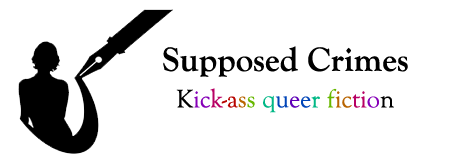
It’s Bisexual Visibility Day, and I’m here to talk about what that means in the context of books and writing.
A conversation with a colleague prompted me to think more about this question: Why don’t we see more books with bisexual protagonists in different-gender relationships? Not merely a passing mention or objectification, but bisexual people being visibly, proudly queer within the context of having a partner of another gender.
The answer to this is complex, and I’m not going to attempt to explain every part in detail. I will say that reader expectation factors in heavily, and a lot of people bundle identity with behavior. Bisexuality is not always understood as a completely formed identity rather than the actions of someone who is really gay or straight.
This tends to play out in writers’ minds as well. Tropes around bisexuality abound, and most of them tend to be pathways to picking a side. In romance, “gay for you” is common (where a previously heterosexually-behaving person suddenly becomes exclusively gay due to a relationship). In literary and speculative fiction, bisexuals are sometimes treated as swingers or “enlightened” heterosexuals or people who experimented that one time in college. (And those are if bisexuality is shown with any positivity; we haven’t even touched on the ubiquity of evil, hurtful, or badly-behaved bisexuals.)
Avoiding the B-word is frequent even when there’s some indication that a character may be bisexual. There isn’t anything inherently wrong with using other terms, but they can be jarring and feel more like the author’s fear or prejudice than someone’s genuine self-identification. More than one of the books I’ve reviewed used phrases such as “bisexual or gay or whatever” and “I don’t like to label it.” The first one is problematic on its own. The second isn’t, until one realizes how often it shows up.
Now to the issue of bisexuals in different-gender relationships. We exist, and our queerness should never be in question. Not in real life and not in books. Unfortunately, it poses a problem for many reviewers: too gay for mainstream, to straight for LGBTQ+ circles.
On this Bisexual Visibility Day, I invite readers to stretch their minds. Don’t make assumptions about a bisexual story until you’ve read it. Don’t assume that a different-gender couple is always cisgender. Don’t assume that they emulate heteronormative relationship dynamics, whatever their genders. Don’t assume that the focus is going to be on who puts what body parts where or that there will even be explicit sex at all. See if the plot itself is of interest to you, and go from there. You may be surprised at what you find between the pages and the ways you may be able to relate to the characters and their situations.
Before you go, have a look at our selection of bisexual books. We feature a lot of polyamory in different configurations as well as books with protagonists and pairings of various genders. (And if I may be so bold, all of my books have at least one bisexual main character, often more than one!) Maybe you’ll find a new favorite read. Who knows?
